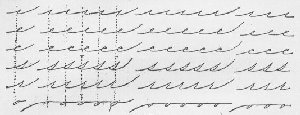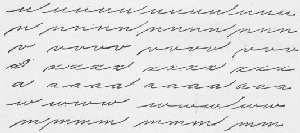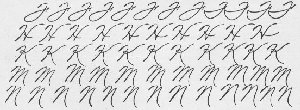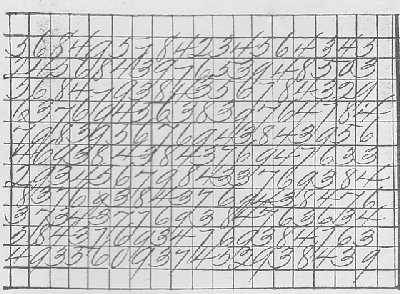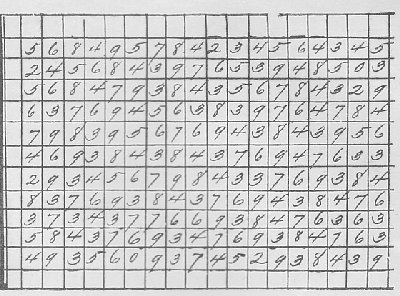|
The author is unable to decide at what points in the course reviews should be given. The matter of review must be dependent upon the thoroughness with which the lessons have been mastered in their regular order. The ability of students to use and apply muscular movement as explained in the preceding lessons should determine the review question.
Enough attention has now been given to movement development, movement application, speed and other essentials, to enable those who are following this course to proceed in their practice of the following, capital drills without special instructions, but there should still be frequent reviews.
Definiteness is essential in business writing. There should be a definite starting point and a definite ending point in every letter. Every curve and every loop should be definite and have a definite place in the process of construction. In studying the forms of the letters here given, bear this in mind. Capital B may end in a dot, as shown in the greater number of the letters given above, and it may end in an angular turn, furnishing a connective stroke for the letters following. The count for capital B is 1, 2, 3, and a fair practice speed is fifty to the minute. It is often an advantage to go over the path of the letters or exercises with the pen in the air. This method is especially helpful to a student whose muscles are hard and who finds difficulty in overcoming the tendency to keep the muscles of the arm and body in a rigid condition. This plan has been suggested in former paragraphs, and we consider it of sufficient importance to receive emphasis here. Another plan which the author has recently found helpful to students who write with strained muscles, is to place a paperweight on the paper, and write with the left arm hanging at the side. Under this plan the tension on the right arm is relieved at once. Still another plan to relieve this tension so common among beginners, is to select some easy drill like small o or m, and make it across the lines of the paper while keeping the eyes fixed upon some object at a distance and on a level with the eyes when the body is fairly erect.
In twelve of the business capitals we have the fish-hook, or small loop beginning. Most pupils find this style of starting the capital letters somewhat difficult at first, but when fully mastered it becomes a favorite. It is of sufficient importance to be given considerable study and practice. A careful study and comparison of these capitals will show that in F, Q, W, X, and Z the main downward strokes are curved much more than in H, K, M, and N, while in U, V, and Y compound curves are used in these main strokes.
Work faithfully on every letter. Repeat the form of each letter over and over until decided improvement can be seen. Make frequent comparisons. Study length, breadth, curves and connections closely. Rate of practice speed to the minute, F, sixty; H, thirty-five to forty; M, forty-five to fifty-five; N, sixty.
Rate of practice speed, Q, thirty-seven; U, fifty-six; V, sixty-eight; W, forty-four to the minute. POINTS TO OBSERVE.—Capital Q is the enlarged form of the figure 2. The last parts of capitals U, V, and W are shorter than the other parts, and the first main strokes in U and V are exactly alike. In making capital W check the motion a little at the base line in the first main downward stroke, as this will aid in the construction of the first part.
See how lightly you can carry the pen over the paper. Barely let the points of the pen touch it. Make a test of the movement with the pen above the paper, and when fully ready for action make from sixty to seventy good letters to the minute.
Do not make the beginning part too high; it should be but little more than two-thirds the entire height of the letter. Note particularly that the last part curves over the top of the main (first) part without touching it. Time and hard work will be important factors in developing this letter. Be earnest, be faithful. The count is 1, 2, 3, 4, and about forty-five letters should be made to the minute.
Make a few letters in the air as a preliminary movement drill before beginning active work. As will be readily seen, nearly all the main oval part is at the left of the beginning stroke. The count is two, and from fifty to sixty letters should be made to the minute. Make a full page and practice steadily, not spasmodically. This letter is a good movement drill. Count three, and be sure to connect the last part with the first, in a loop a little above the center of the letter. From forty-five to fifty good letters should be made to the minute. Nothing within the range of business writing is more important to the average bookkeeper or office clerk than good figures. In many lines of accounting thousands of business figures are made without the writing of a single word. This, in a measure, is true in many branches of statistical work connected with railroad bookkeeping where headings are printed and page after page is filled with figures. The first requisite is legibility, and its importance cannot be emphasized too much. While, in writing the letters in a word, each may be known by the context, in making figures, each must depend upon itself for legibility. How important then that each figure should be so formed that its value, in a group or by itself, cannot be mistaken.
Figures should be made small. Students sometimes think that large figures are necessarily the plainest, but such is not the case. Examine carefully the diagram presented herewith. On the first, the figures are absolutely plain; one could not be mistaken for another, and yet their extreme size in the space in which they are placed make them difficult to read. On the second, the same figures, made no better, but a great deal smaller. Please note carefully the fact that these, surrounded as they are by white paper, and much smaller, are much more legible, even at a distance, than are the large figures. Students who have practiced in copybooks have almost invariably acquired the habit of making figures three or four times too large. Those that we present for models from which to practice are large enough for ordinary use. If occasion demands, it will be easy to make the figures larger. One-eighth of an inch is perhaps high enough for ordinary figures, while in some places it would be advantageous to make them even smaller. Naught, a disconnected small o, always closed at the top; one, a plain oblique straight line; two, a small loop or a dot in beginning, a full right curve to base, and a small loop flat on base; three, beginning, with dot, upper part about one-third entire size, made with a great deal of side motion; four, oblique straight line, horizontal straight line finished with a slight left curve extending a little above the first part and resting on the base line; five, beginning with plain downward oblique line, well rounded in main part, and with the horizontal line at top always connected with first part; six may extend above the other figures, and should always be finished with a small loop, the finishing point being brought to base line each time. There are no angles in the form of seven given here. A more graceful form could have been produced had two angular turns been made, one at extreme upper left and other at extreme upper right point, but such a form sacrifices speed while gaining nothing in legibility. Figure seven extends below the base line. Our figure eight begins at the upper left side, while some who make this figure well begin on opposite side. The upper part of figure nine rests on base line, with stem extending below. Close the upper part. In making the figure one, draw the hand toward you with a quick, light motion, sliding on the third and fourth fingers. Uniformity in height and slant are the two important points to observe. The development and application of a lateral oval motion will aid in the construction of the figure two. In making the figure two in class drill a count of three should be used, 1, 2, 3, 1, 2, 3, etc., or dot, 2, 3. Notice the exercise preceding the figure three. The motion used in that exercise will produce a good figure three if properly applied; 1, 2, 3, or dot, 2, 3 is the count used. A count of three is also used in four and five, but for six, seven and nine, a count of two. Several lessons should be given to drilling on the figures singly before grouping them, but as soon as the forms are mastered and the student can make them at a fair rate of speed, it is best to drill in a miscellaneous order somewhat as follows: 1, 0, 2, 6, 9, 8, 5, 4, 3, 0, 9, 6, 7, 2, 8, 9, 3, 5, 6, 9, 2, 1, 5, 8, 6, 9, 5, 4, 6, 9, 3, 7, 8, etc. No particular order is necessary, but the aim should be to repeat one figure as often as another. Figures taken singly, 150 naughts, 175 ones, 80 twos, 75 threes, 80 fours, 75 fives , 100 sixes, 95 sevens, 90 eights and 100 nines per minute. Figures taken promiscuously, not less than ninety-five good figures to the minute. This rate can be increased materially by repeated effort. Persistence brings success. Practice steadily and faithfully. 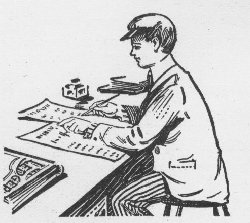 BOOK IX |
